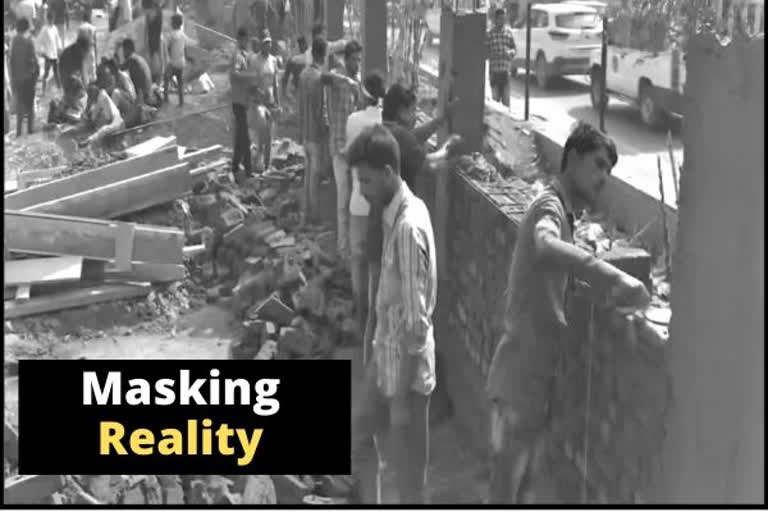Hyderabad: Ahead of US President Donald Trump's visit to India later this month, the Ahmedabad Municipal Corporation (AMC) is constructing a 400-metre wall in front of a slum along the road connecting Sardar Vallabhbhai Patel International Airport to Indira Bridge.
Trump, who had earlier pledged to build a wall along the United States’ border with Mexico, will visit India on February 24-25.
The reason for not letting the US leader get a glimpse of the slums housing around 800 families, has not been disclosed but the act has attracted reproving comments.
But this is not the first time, Government has gone the extra mile to conceal or cover up India's reality.
When Ivanka Trump visited Hyderabad in 2017 to attend the 8th Global Entrepreneurship Summit (GES), nearly 400 beggars and homeless people were detained by the Police and lodged in a rehabilitation facility at Chanchalguda jail and in shelter homes.
In 2010, ahead of the Commonwealth Games, Delhi government erected facades across the capital to shut out slum dwellers from public view and sent back beggars to the towns and villages from where they had migrated. Similarly, thousands of pavement dwellers were herded into large trucks and dumped a hundred kilometers away, when US President Bill Clinton visited Hyderabad.
But why only talk about India, when the government of other countries have followed the same suit- hiding what they don't want others to see. In 2007, a study by the UK's Centre on Housing Rights and Evictions claimed more than 2 million people had been driven from their homes since 1988 to make way for various Olympics.
When Democrats landed in Denver in 2008, a nonprofit organisation, Colorado Coalition for the Homeless distributed movie tickets so that they would not disturb the Democratic National Convention.
Countries hosting Olympic games have also found it shameful to let their country's impoverishment and poverty be visible to outsiders. Ahead of the 2016 Olympics, private security officers in Brazil removed the homeless from tourist areas and brought them to police stations on the instruction of the Rio de Janeiro government officials. A report by the Centre on Housing Rights and Eviction indicated that the number of Beijing residents displaced as a result of Olympics-related urban (re)development projects between 2000 and 2008 were around 1.5 million (about 14 per cent of Beijing’s permanent residents).
ALSO READ: Ahead of Trump's India visit, wall being constructed near slum in Ahmedabad
In Athens, 2,700 Roma were reportedly evicted in 2004, during the Olympic games. Legislative measures also were introduced to simplify the expropriation of private property to smoothen the process of eviction. For the 1996 Atlanta Games, around 30,000 poor residents were displaced due to gentrification. About 2,000 public housing units were demolished. In addition, legislation was introduced to criminalise homelessness. Leading up to the 1992 Barcelona Olympics, more than 400 families were displaced to make room for the Olympic Village, 20 families were evicted from the site of the Olympic stadium and 200 other families were displaced for the construction of ring roads. In Seoul, during the preparations for the 1988 Seoul Olympic Games, one of the most brutally oppressed groups was the low-income communities whose settlements were near the Olympic torch path. As the government did not want them to be visible to the media, 720,000 people were forcibly displaced during the preparation for the Summer Olympic Games.



